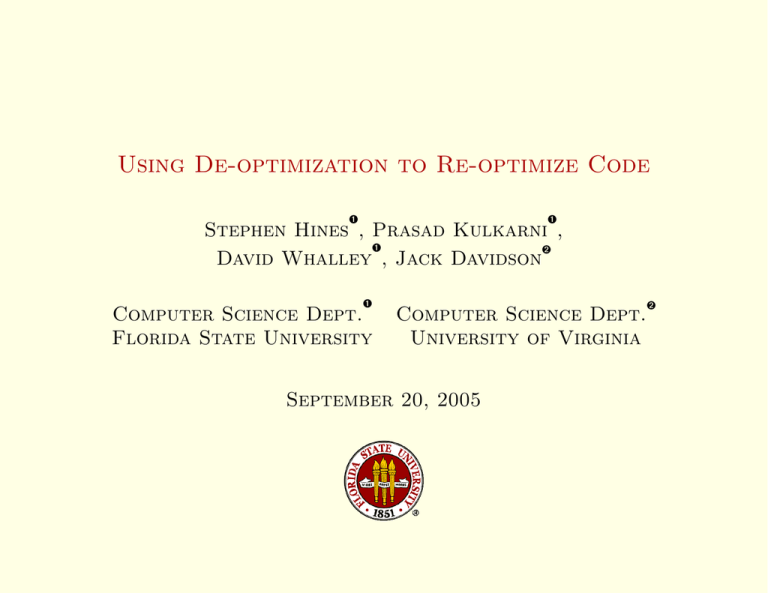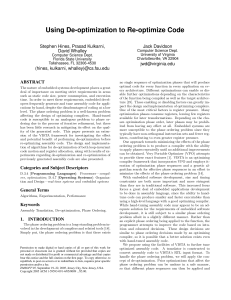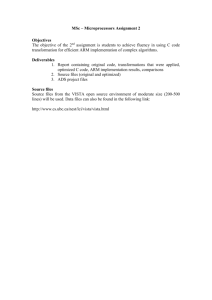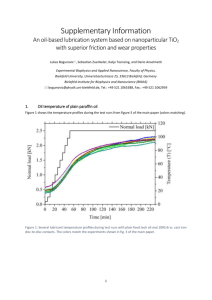Using De-optimization to Re-optimize Code
advertisement

Using De-optimization to Re-optimize Code
➊
➊
Stephen Hines , Prasad Kulkarni ,
➊
➋
David Whalley , Jack Davidson
➊
Computer Science Dept.
Florida State University
Computer Science Dept.
University of Virginia
September 20, 2005
➋
Ê Introduction
• Phase Ordering Problem
– No sequence of optimization phases will produce optimal code for all
functions in all applications on all architectures
– Long standing problem for compiler writers
– Register pressure is a critical factor
• Embedded Systems Development
– Greater tolerance for longer, more complex compile processes
? Large number of devices produced → even small savings add up
? Tighter constraints (code size, power, real-time)
? Fewer registers and features than modern CPUs
? Hand-tuned assembly code can suffer from an analogous problem to
phase ordering
Using De-optimization to Re-optimize Code
slide 1
u Reducing Phase Ordering Effects
• Methods to Diminish Problems with Phase Ordering
– Iteration of optimization phases (VPO)
– Test combinations of optimization phases for best sequence (VISTA)
• Problems with Current Methodology
– Current solutions work with higher-level languages (not assembly)
– Not able to take into account previously applied optimizations, due to
hand-tuning or another compiler (e.g. no spare registers for allocation)
Using De-optimization to Re-optimize Code
slide 2
u Proposed Approach
• Translate assembly code back to intermediate languages for input to an
optimizer.
• Undo the effects of various optimization phases to allow for different
phase ordering decisions (De-optimization).
• Re-optimize the code using new phase orderings to improve performance.
Using De-optimization to Re-optimize Code
slide 3
u Outline
Ê Introduction
Ë Related Work
Ì VISTA Framework
Í Assembly Translation
Î De-optimization
Ï Experimental Results
Ð Conclusions
Using De-optimization to Re-optimize Code
slide 4
Ë Related Work
• Binary translation
– Executable Editing Library (EEL)
– University of Queensland Binary Translator (UQBT)
• Link-time optimizations – ALTO
• De-optimization
– Debugging optimized executables
– Reverse engineering
Using De-optimization to Re-optimize Code
slide 5
Ì VISTA Framework
• VPO Interactive System for Tuning Applications
• Graphical viewer connected to VPO (Very Portable Optimizer) backend
• Interactive approach to tuning code (arbitrary phase orderings permitted,
along with hand modification of code)
• Transformations performed on RTLs (Register Transfer Lists) – machineindependent representations of instruction semantics
• Automatic tuning of code via a genetic algorithm search for effective
phase sequences
Using De-optimization to Re-optimize Code
slide 6
u Overview of Modified Framework
Using De-optimization to Re-optimize Code
slide 7
Í Assembly Translation
• Converting optimized assembly code to VISTA intermediate language
(RTLs)
• Preserving semantics
– Information Loss – high-level languages have more semantic content
than low-level representations
– Local Variable Confusion – local stack variable start and end points,
as well as actual data types
– Maintaining Calling Conventions – recognizing function parameters
and return values
Using De-optimization to Re-optimize Code
slide 8
u Implementation Strategy
• ASM2RTL – translate assembly code → VISTA RTL format
• Split into machine-dependent and machine-independent portions:
– Sun SPARC
– Texas Instruments TMS320c54x
– Intel StrongARM ← used for these experiments
• Translate each line individually and perform a pass to patch things up.
• VISTA reconstructs additional information from contextual clues.
• Simplify problems with memory consistency and calling conventions.
Using De-optimization to Re-optimize Code
slide 9
u Memory Consistency
• VISTA reorganizes local variables during Fix Entry Exit
• Cannot allow splitting of arrays, structures or large data types → other
functions will not be able to interface with them
• Fixed by supplying translator with annotations regarding functions and
corresponding stack information for local structures and arrays
Using De-optimization to Re-optimize Code
slide 10
u Following Calling Conventions
• VISTA can reconstruct some but not all information regarding registers
and stack locations used for special purposes (e.g. arguments, return
values):
– No mechanism for knowing how many registers are used as arguments
and thus need to be preserved across a call
– No distinguishing between stack local variables and arguments
• Knowing the number of parameters and return types of each function
(signature), we can recreate the proper environment.
• Variable length argument functions are pre-processed with a tool to
detect actual arguments used.
• Function pointers are handled conservatively.
Using De-optimization to Re-optimize Code
slide 11
u Translation Tradeoffs
• Could assume worst case scenarios and not require annotations
– Stack layout → one large array/structure that is unable to be split
? Most optimizations ignore arrays/structures since they are difficult
to manipulate while guaranteeing correctness.
? Decreases chance that re-optimization will be beneficial
– All argument registers and all stack locations may be parameters.
? Stack variables are already unable to be adjusted (as above).
? Optimizations such as Dead Assignment Elimination will be less
effective since we will have undetectable dead registers.
• Luckily, a simple code inspection is usually all that is needed to extract
the necessary information.
Using De-optimization to Re-optimize Code
slide 12
Î De-optimization
• Undo the effects of previous transformations on the code.
• Enable VISTA to reapply those phases in a potentially different order.
• Focus on optimizations that are likely to affect register pressure:
– Loop-invariant Code Motion
– Register Allocation
Using De-optimization to Re-optimize Code
slide 13
u Loop-invariant Code Motion
• Attempts to decrease unnecessary computations by moving RTLs that
are not loop-dependent to the loop preheader
• Loops are handled from most deeply nested to least deeply nested
• For an RTL/instruction to be considered loop-invariant:
À
Á
Â
Ã
All source operands must be loop-invariant
Must dominate all loop exits
No set register can be set by another RTL in the loop
No set register can be used prior to being set by this RTL
Using De-optimization to Re-optimize Code
slide 14
u De-optimizing LICM
1
2
3
4
5
6
7
8
9
foreach loop ∈ loops sorted outermost to innermost do
perform loop invariant analysis() on loop
foreach rtl ∈ loop→preheader sorted last to first do
if rtl is invariant then
foreach blk ∈ loop→blocks do
foreach trtl ∈ blk do
if trtl uses a register set by rtl then
insert a copy of rtl before trtl
update loop invariant analysis() data
Using De-optimization to Re-optimize Code
slide 15
u Performing the De-optimization
Comments
Load LI global
Init loop ctr
Label L11
Calc array address
Add array value
Loop ctr increment
Set CC
Perform loop 80X
RTLs Before
...
+r[10]=R[L44]
+r[6]=0
L11:
+r[2]=r[10]+(r[6]{2)
+r[5]=r[5]+R[r[2]]
+r[6]=r[6]+1
+c[0]=r[6]-79:0
+PC=c[0]’0,L11
...
Using De-optimization to Re-optimize Code
slide 16
u Performing the De-optimization
Comments
Load LI global
Init loop ctr
Label L11
Load LI global
Calc array address
Add array value
Loop ctr increment
Set CC
Perform loop 80X
RTLs Before
...
+r[10]=R[L44]
+r[6]=0
L11:
+r[2]=r[10]+(r[6]{2)
+r[5]=r[5]+R[r[2]]
+r[6]=r[6]+1
+c[0]=r[6]-79:0
+PC=c[0]’0,L11
...
Using De-optimization to Re-optimize Code
RTLs After
...
+r[10]=R[L44]
+r[6]=0
L11:
+r[10]=R[L44]
+r[2]=r[10]+(r[6]{2)
+r[5]=r[5]+R[r[2]]
+r[6]=r[6]+1
+c[0]=r[6]-79:0
+PC=c[0]’0,L11
...
slide 16
u Register Allocation
• Attempts to place local variables live ranges into registers → save on
memory access overhead costs
• Traditionally treated as a graph coloring problem, which is NP-complete
• Register allocation algorithms work with interference graphs
– Vertices ← variable live ranges
– Edges ← connect live ranges that overlap or conflict
– Colors ← available registers
• Priority-based coloring weights live ranges according to various
heuristics to find a good solution if graph cannot be completely colored
Using De-optimization to Re-optimize Code
slide 17
u De-optimizing Register Allocation
• Construct a register interference graph (RIG)
• Replace register live ranges from RIG depending on their span
– Intrablock live ranges just get remapped to pseudo-registers
– Interblock live ranges get remapped to pseudo-registers as well as a
new local variable for storage
• Insert stores of new local variables after sets of these registers
• Insert loads of new local variables before uses of these registers
Using De-optimization to Re-optimize Code
slide 18
u Prior to De-optimization
#
1
2
3
4
5
6
7
8
9
10
11
12
13
RTLs
r[6]=R[L21];
r[12]=R[r[6]+0];
r[3]=R[L21+4];
c[0]=r[12]-0:0;
R[r[3]+0]=r[12];
r[4]=r[1];
r[3]=r[0];
r[5]=r[2];
r[0]=r[12];
PC=c[0]:0,L0001;
r[2]=R[r[12]+0];
R[r[3]+0]=r[2];
r[3]=R[r[12]+4];
Deads
r[3]
r[1]
r[0]
r[2]
c[0]
r[2]r[3]
Using De-optimization to Re-optimize Code
#
14
15
16
17
18
19
20
21
22
23
24
25
26
RTLs
R[r[4]+0]=r[3];
r[2]=R[r[12]+8];
r[1]=R[r[12]+12];
R[r[5]+0]=r[2];
R[r[6]+0]=r[1];
ST=free; =r[0];
r[2]=R[L21+8];
r[3]=R[r[2]+0];
r[3]=r[3]-1;
R[r[2]+0]=r[3];
PC=RT;
L0001:
PC=RT;
Deads
r[3]r[4]
r[12]
r[2]r[5]
r[1]r[6]
r[2]r[3]
slide 19
u After De-optimizing Register Allocation
#
1a
1b
2a
2b
2c
3
RTLs
Deads
r[32]=R[L21];
R[r[13]+ dequeue 0]=r[32]; r[32]
r[32]=R[r[13]+ dequeue 0];
r[33]=R[r[32]+0];
r[32]
R[r[13]+ dequeue 1]=r[33]; r[33]
r[34]=R[L21+4];
4a
4b
5a
5b
6a
6b
7a
7b
8a
8b
9a
9b
10
r[33]=R[r[13]+ dequeue 1];
c[0]=r[33]-0:0;
r[33]=R[r[13]+ dequeue 1];
R[r[34]+0]=r[33];
r[35]=r[1];
R[r[13]+ dequeue 2]=r[35];
r[36]=r[0];
R[r[13]+ dequeue 3]=r[36];
r[37]=r[2];
R[r[13]+ dequeue 4]=r[37];
r[33]=R[r[13]+ dequeue 1];
r[0]=r[33];
PC=c[0]:0,L0001;
...
Using De-optimization to Re-optimize Code
#
#
#
#
#
#
#
Comments
r[6] → r[32]
Store pseudo r[32]
Load pseudo r[32]
Perform actual op
Store pseudo r[33]
Intrablock live range
Use pseudo r[34]
r[33]
# c[0] not replaceable
r[33]r[34]
r[1]
r[35]
r[0]
r[36]
r[2]
r[37]
#
#
#
#
#
#
#
#
#
#
#
r[33]
c[0]
Intrablock r[34] dies
Incoming argument r[1]
is not replaceable
Incoming argument r[0]
is not replaceable
Incoming argument r[2]
is not replaceable
r[0] is outgoing
argument to free()
Branch uses only c[0]
so no replacements
slide 20
u After Register Re-assignment
#
1a
1b
2a
2b
2c
3
4a
4b
RTLs
Deads
r[12]=R[L21];
R[r[13]+ dequeue 0]=r[12]; r[12]
r[12]=R[r[13]+ dequeue 0];
r[12]=R[r[12]+0];
R[r[13]+ dequeue 1]=r[12]; r[12]
r[12]=R[L21+4];
r[3]=R[r[13]+ dequeue 1];
c[0]=r[3]-0:0;
r[3]
5a
5b
6a
6b
7a
7b
8a
8b
9a
9b
10
r[3]=R[r[13]+ dequeue 1];
R[r[12]+0]=r[3];
r[12]=r[1];
R[r[13]+ dequeue 2]=r[12];
r[12]=r[0];
R[r[13]+ dequeue 3]=r[12];
r[12]=r[2];
R[r[13]+ dequeue 4]=r[12];
r[12]=R[r[13]+ dequeue 1];
r[0]=r[12];
PC=c[0]:0,L0001;
...
Using De-optimization to Re-optimize Code
#
#
#
#
#
Comments
r[12] is first non-arg
scratch register
Note use of r[12] to
combine 2 distinct live
ranges in these lines
# First appearance of
# r[3] since there are
# currently 2 live ranges
r[3]r[12]
r[1]
# Save argument r[1]
r[12]
r[0]
# Save argument r[0]
r[12]
r[2]
# Save argument r[2]
r[12]
r[12]
c[0]
# Live regs leaving block
# are r[0] and r[13] (SP)
slide 21
u After Re-optimization
#
1
2
3
4
5
6
7
8
9
10
11
12
13
RTLs
r[5]=R[L21];
r[4]=R[r[5]];
r[12]=R[L21+4];
c[0]=r[4]:0;
R[r[12]]=r[4];
r[4]=r[1]
r[8]=r[0];
r[5]=r[2]
r[0]=r[4];
PC=c[0]:0,L0001;
r[12]=R[r[4]];
R[r[8]]=r[12];
r[12]=R[r[4]+4];
Deads
r[12]
r[0]
c[0]
r[8]r[12]
Using De-optimization to Re-optimize Code
#
14
15
16
17
18
19
20
21
22
23
24
25
26
RTLs
R[r[1]]=r[12];
r[12]=R[r[4]+8];
r[1]=R[r[4]+12];
R[r[2]]=r[12];
R[r[5]]=r[1];
ST=free; =r[0];
r[12]=R[L21+8];
r[1]=R[r[12]];
r[1]=r[1]-1;
R[r[12]]=r[1];
PC=RT;
L0001:
PC=RT;
Deads
r[1]r[12]
r[4]
r[2]r[12]
r[1]r[5]
r[1]r[12]
slide 22
Ï Experimental Results
• Hand-tuned assembly code is usually proprietary, so we will focus on
optimized C code from a different compiler:
– O2 optimized benchmarks with GCC 3.3 for the ARM
– MiBench: bitcount, dijkstra, fft, jpeg, sha, stringsearch
• Evaluate benefit of re-optimization using VISTA’s genetic algorithm
search against de-optimization plus re-optimization
• Fitness criteria tested include static code size, dynamic instruction count
and a 50%/50% mix
Using De-optimization to Re-optimize Code
slide 23
u Benefit of De-optimization
Benchmark
Compiler
Strategy
Re-opt
De-opt
Re-opt
dijkstra
De-opt
Re-opt
fft
De-opt
Re-opt
jpeg
De-opt
Re-opt
sha
De-opt
Re-opt
stringsearch
De-opt
bitcount
average
Re-opt
De-opt
Opt. for Space
static
dynamic
count
count
2.32
2.32
1.30
2.16
0.19
0.19
4.30
5.20
5.99
5.99
0.92
3.23
%
%
%
%
%
%
%
%
%
%
%
%
2.50 %
3.18 %
0.00
0.00
2.70
2.73
0.00
0.35
10.61
10.53
4.39
4.39
0.09
0.09
%
%
%
%
%
%
%
%
%
%
%
%
2.97 %
3.01 %
Using De-optimization to Re-optimize Code
Opt. for Speed
static dynamic
count
count
2.32
2.32
1.30
3.03
0.19
0.19
4.30
4.30
3.89
3.89
0.92
3.23
%
%
%
%
%
%
%
%
%
%
%
%
2.15 %
2.83 %
0.00
0.00
2.70
2.73
0.00
0.00
10.61
10.61
6.27
6.27
0.09
0.09
%
%
%
%
%
%
%
%
%
%
%
%
3.28 %
3.28 %
Opt. for Both
static dynamic
average
count
count
2.32
2.32
1.30
3.03
0.19
0.19
4.30
4.30
5.99
5.99
0.92
3.23
%
%
%
%
%
%
%
%
%
%
%
%
2.50 %
3.18 %
0.00
0.00
2.70
2.73
0.00
0.00
10.61
10.61
4.39
4.39
0.09
0.09
%
%
%
%
%
%
%
%
%
%
%
%
1.16
1.16
2.00
2.88
0.09
0.09
7.46
7.46
5.19
5.19
0.51
1.66
%
%
%
%
%
%
%
%
%
%
%
%
2.97 % 2.73 %
2.97 % 3.07 %
slide 24
Ð Conclusions & Future Work
• Embedded applications have rigid constraints regarding code size, power
consumption and/or execution time.
• De-optimization can be used to roll back some existing phase orderings
from other compilers/hand tuning.
• Improvements can be achieved when combining de-optimization with a
compiler framework that can evaluate multiple phase orderings using a
genetic algorithm search.
• Further de-optimizations can be developed for phases that impact register
pressure, including common subexpression elimination.
• ASM2RTL + de-optimizations may also prove beneficial when working
with actual hand-tuned assembly code.
Using De-optimization to Re-optimize Code
slide 25
u The End
Thank you!
Questions ???
See us for a demo of VISTA!
Using De-optimization to Re-optimize Code
slide 26







